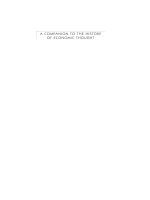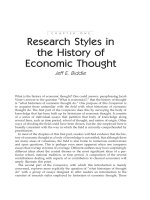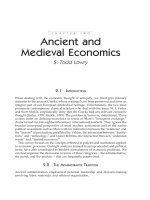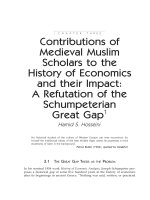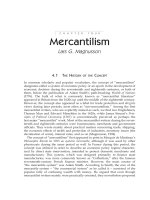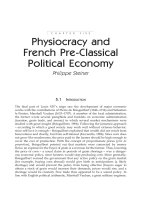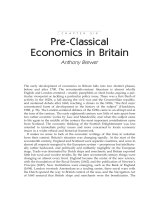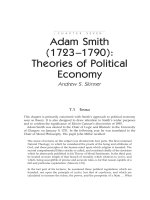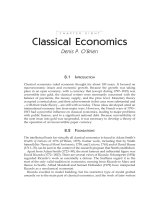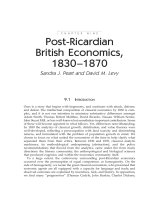A Companion to the History of Economic Thought - Chapter 4 ppsx
Bạn đang xem bản rút gọn của tài liệu. Xem và tải ngay bản đầy đủ của tài liệu tại đây (192.38 KB, 15 trang )
46 L. G. MAGNUSSON
CHAPTER FOUR
Mercantilism
Lars G. Magnusson
4.1 THE HISTORY OF THE CONCEPT
In common scholarly and popular vocabulary, the concept of “mercantilism”
designates either a system of economic policy or an epoch in the development of
economic doctrine during the seventeenth and eighteenth centuries, or both of
them, before the publication of Adam Smith’s path-breaking Wealth of Nations
(1776). The bulk of what is commonly known as “mercantilist literature”
appeared in Britain from the 1620s up until the middle of the eighteenth century.
However, the concept also appeared as a label for trade protection and dirigiste
views during later periods, most often as “neo-mercantilism.” Among the first
mercantilist writers, who are explicitly named as such, we find two Englishmen,
Thomas Mun and Edward Misselden in the 1620s, while James Steuart’s Prin-
ciples of Political Oeconomy (1767) is conventionally perceived as perhaps the
last major “mercantilist” work. Most of the mercantilist writers during the seven-
teenth and eighteenth centuries were businessmen, merchants and government
officials. They wrote mainly about practical matters concerning trade, shipping,
the economic effects of tariffs and protection of industries, monetary issues (the
devaluation of coins), interest rates, and so on (Magnusson, 1994).
The concept of “mercantilism” first appeared in print in Marquis de Mirabeau’s
Philosophie Rurale in 1763 as systeme mercantile, although it was used by other
physiocrats during the same period as well. In France during this period, the
concept was utilized in order to describe an economic policy regime character-
ized by direct state intervention, intended to protect domestic merchants and
manufacturers. This system, which was designed primarily to finance state
manufactories, was more commonly known as “Colbertism,” after the famous
seventeenth-century French finance minister. However, the main creator of
“the mercantile system” was Adam Smith. According to Smith, the core of the
mercantile system – “the commercial system” as he called it – consisted of the
popular folly of confusing wealth with money. He argued that even though
mercantilist writers mainly were practically oriented, they nevertheless proposed
MERCANTILISM 47
an analytic principle; namely, that a country must export more than it imported,
which would lead to net inflow of bullion. This goal would be achieved through
an active policy and thus make the state – or commonwealth – richer. This was
the core argument of the much debated so-called “positive balance of trade theory.”
According to Adam Smith, the main architect of the mercantile system of eco-
nomic thinking was the English writer and tradesman Thomas Mun (1571–1641).
His main published writings appear in two short treatises, A Discourse of Trade
from England unto the East Indies (1621) and perhaps the more important Eng-
land’s Treasure by Forraign Trade (1664). Adam Smith picked out this last tract –
published posthumously after Mun’s death, but probably written during the
late 1620s – as the archetype of mercantilist texts; its manifesto. Underlying this
erroneous theory of the favorable gains from a positive trade balance lurked –
further according to Smith – a mercantile special interest, which used the idea of
a positive balance of trade in order to propagate a protective trade policy in
general, including duties on imports, tariffs, bounties, and so on. According to
Smith, the mercantile system implied a gigantic conspiracy on behalf of master
manufacturers and merchants in order to cheat the public and consumers. This
view of mercantilism as a policy of rent-seeking developed by special interests
has in recent times been further elaborated by economists inspired by positive
and public-choice theory; especially by Robert E. Eklund and Robert D. Tollison,
who have defined mercantilism as “a rent-seeking society.” Hence, according to
their view, rent-seeking was the real, but most often hidden, agenda behind the
mercantilist doctrines and, especially, the view that trade among nations, by and
large, was a zero-sum game; what one gained in trade someone else lost, as
stated by many pamphleteers during this period (Ekelund and Tollison, 1997).
From Smith and onwards the view of the mercantile system, or simply mer-
cantilism, as state dirigisme, and sometimes also protectionism, in order to sup-
port a special interest with the aid of the positive balance of trade, was carried
further by classical political economy. In France, Auguste Blanqui and, in Britain,
J. R. McCulloch were those who were most influential in creating this image
of mercantilism. In the 1830s, Richard Jones argued that the seventeenth century
had seen the emergence of a protective trade system that built on “the almost
romantic value which our ancestors set upon the possessions of the precious
metals” (Jones, 1964 [1859], p. 312). Hence, mercantilism was based on the King
Midas folly and could be described as a mere fallacy. Certainly, already Hume
and others before him had used a simple specie-flow argument to correct this
mistake: a net inflow of bullion must certainly mean a relative increase in prices,
which through the export and import mechanism will tend to correct itself.
Smith and his followers were thus quite content to draw the conclusion that the
argument for protection and against free trade was based on a mere intellectual
and analytic mistake.
During the nineteenth century, this viewpoint was contested by the German
historical school, which preferred to define mercantilism as state-making in a gen-
eral sense. Hence, the doctrines of mercantilism were no mere folly. Instead, they
were the rational expression of nation-building during the early modern period
(i.e., 1500–1750). The definition of mercantilism as a process of state-making
48 L. G. MAGNUSSON
during a specific historical epoch first appeared in a series of articles published
from 1884 to 1887 by the German historical economist Gustav Schmoller. These
were translated into English as The Mercantile System and its Historical Significance
(1896). “Mercantilism” was the term that Schmoller used to designate the policy
of unity and centralization pursued by the Prussian government in particular
during the seventeenth and eighteenth centuries. Hence, mercantilism expressed
the economic interest of the state and regarded economic wealth as a rational
means to achieve political power. According to Schmoller, mercantilism expressed
the “. . . economic interests of the whole states” (Schmoller, 1896, p. 59). With
his roots in the older German historical school – which included such outstand-
ing figures as Wilhelm Roscher and Friedrich List – Schmoller argued that the
core of mercantilism consisted of dirigiste ideas propounding the active role of
the state in economic modernization and growth. Although the balance of trade
theory was perhaps an analytic blind shot, it was rational in a more general and
historical sense, as it emphasized the pivotal role of protectionism and tariffs to
protect new, emerging infant industries in order to create a modern industrial
nation.
These two widely different definitions of mercantilism are certainly not easy to
combine. However, an attempt was made by the Swedish economic historian Eli
Heckscher, who in his massive Mercantilism (1955, first published in 1931) aimed
to present mercantilism both as a system of economic thought and of economic
policy. As a broader school of economic doctrine, he principally accepted Adam
Smith’s description. He was in agreement with the balance of trade theory being
at the core of the mercantilist doctrine. Moreover, he agreed that it was a folly
that later on was upset by modern thinking, such as Hume’s specie-flow mech-
anism. His explained the core of the positive balance of trade theory by pointing
at what he believed was a distinct “fear of goods” that dominated the popular
mind of the seventeenth century. According to him, the fear of goods and love
of money was an expression of the transition from a barter economy to a money
(gold and silver) economy, which took place during this period.
However, Heckscher also regarded mercantilism as a system of economic policy.
And as such its core logic was – as the historical economists emphasized –
state-building. Hence, with the aim of pursuing the goal of state power, the
mercantilists developed a number of nationalist economic policy tools, including
tariffs. Therefore, the British Navigation Act of 1651, as well as the establishment
of national standards of weights and measurements, a national monetary system,
and so on, could be viewed as the outcome of the same mercantilist policies.
It is not easy to grasp, in Heckscher’s synthesis, how mercantilism as a system
of economic theory, a system of economic policy, and a world-view (moral
philosophy) relate to each other. Unfortunately, and for this reason, his grand
construction has caused grave misunderstandings. For example, Jacob Viner has
therefore unfairly interpreted Heckscher as a follower of Schmoller and the his-
torical school (Viner, 1991). Following Smith, Viner was eager to point out that
a main characteristic of the mercantilist writers was their confusion of wealth and
money. Unlike Heckscher’s more complicated picture, he thus portrayed the
mercantilist writers as bullionists pure and simple (Viner, 1937).
MERCANTILISM 49
Another response to Heckscher became common in the heated discussion over
mercantilism in the 1950s and 1960s. As early as 1939, A. V. Judges had vigor-
ously rejected the notion of a particular mercantilist doctrine or system. He stated
that mercantilism had neither a common theoretical core nor any priests to
defend it (Judges, 1969 [1939]). His rejection of mercantilism as a coherent system
was later taken up by a number of British economic historians. For example,
D. C. Coleman denounced the usefulness of mercantilism outright, both as a
description of economic policy and of economic theory; it was “a red-herring of
historiography,” he stated. The main problem with using this concept was that it
gave a false unity to disparate events and ideas. Coleman argued that mercantil-
ism was not a school of economic thinking and doctrine as was, for example, the
physiocratic school of the eighteenth century. It was a concept invented by Adam
Smith, and its core was a literature of seventeenth-century pamphlets that dealt
mainly with practical matters. This literature was neither analytic nor can we
here find any definite theoretical propositions (Coleman, 1969).
The majority of modern interpreters seem to agree with Coleman that mercant-
ilism was no finished system or coherent doctrine in the nineteenth- and twentieth-
century sense. Although “mercantilist” views mainly appeared in pamphlets that
dealt with contemporary economic and political issues, this does not – as several
authors have pointed out – necessarily imply that economic writers during the
seventeenth and eighteenth centuries composed economic texts without some
common objectives, views, and shared concepts in order to make intelligible the
complex world of economic phenomena. Hence, it is perhaps more fruitful to
perceive the situation as if mercantilist writers shared a common vocabulary in
order to argue for specific political and economic viewpoints. On the other hand,
Coleman and others were certainly right when they stressed that commentators
such as Schmoller and Heckscher overemphasized the systematic character of
mercantilism as a coherent system both of economic ideas and of economic policy
that stemmed more or less directly from these doctrines.
Moreover, it seems evident that Smith and his followers helped to cement a
view of the mercantilist writers that made them more “old-fashioned” than they
actually were. As we shall see, rather than being in complete opposition to Smith,
they can – to some extent – be regarded as forerunners of both Smith and the
liberal school. Any first-hand knowledge of their texts will suggest that they
were not totally devoted to dirigisme. Moreover, their methodology and supply-
and-demand analysis has formed the nucleus of modern theorizing ever since.
4.2 THE ENGLISH CONTEXT
Mercantilism is thus perhaps best understood as a literature of pamphlets and
books, mainly of English origin, which primarily dealt with practical political
and economic policy issues, roughly between 1620 and 1750. However, an over-
all objective in much of this literature was the question how England should be
able to achieve national wealth and power. In the bulk of this literature, these
two goals of achieving wealth and power were looked upon as identical. To
50 L. G. MAGNUSSON
some extent, this was perhaps not anything that distinguishes the generation
after Mun from its predecessors or, indeed, from much later “schools” of
economic writers. Such an identity can be traced in English, Italian, French, and
other European economics texts from the sixteenth century and onward. Inter-
preted in this sense, Italian writers such as Giovanni Botero (1544–1617) and
Antonio Serra (1580–?), as well as Spanish writers such as de Vitoria, de Soto, de
Azpilcueta, and Luis de Ortiz during the sixteenth century, were perhaps the
first “mercantilists.” Nor were such ideas absent in later economic writing and
thinking, including that of members of the German historical school from List
and onwards, and followers of the “American system” as well as the British
“free-trade imperialists” during the nineteenth century. Hence, the recommenda-
tion that a state should try to keep as much gold and silver as possible within the
country, or to organize its foreign trade in such a manner that the net export of
manufactured goods is maximized, seems to have been common parlance all
over Europe since at least the early sixteenth century.
However, in the English discussion from the 1620s and onwards we can iden-
tify a number of other topics as well. Hence, the Dutch example provided an
argument for how economic wealth could be achieved through increased inter-
national trade and a great population, as well as more manufactories utilizing in-
creased division of labor. Moreover, an increase in trade and manufacture could
only be accomplished by propounding sound laws and establishing effective
institutions. Thus, most writers were unwilling to put their sole faith in the
self-equilibrating forces of the marketplace in order to achieve wealth and growth.
On the other hand, as many argued, too much interference in the laws of supply
and demand could be just as harmful as none at all. Hence, it is a mistake to
interpret all “mercantilists” as protectionists. After all, during the seventeenth
century “protectionism” was still not a clear-cut concept, and few argued that
duties should be introduced in order to protect domestic industries from foreign
competition. It was only gradually that this viewpoint won ground during that
century and the next. On the contrary, according to most writers on the subject
the main objective of duties was to increase the income of the state.
Hence, English “mercantilism” can to some extent be seen as a special national
case of a broader dirigiste literature, which appeared in a number of European
countries during the sixteenth, seventeenth, and eighteenth centuries, with the
overall aim of making the state powerful and rich, and to this effect proposing
a number of policy recommendations. Among these were included different
proposals for what we perhaps today would call “administered” foreign trade,
as well as the notion of keeping money within the country as much as possible.
Such writers, who appeared all over Europe, were called “consultant administr-
ators” by Joseph Schumpeter. They were especially common in Spain, Austria,
France, and the German states, including Austria (Schumpeter, 1954, pp. 143–
207).
However, it is clear that English mercantilist literature also included some
additional features. As proposed by for instance Joyce Appleby, this was perhaps
due to the fact that many of the English writers were not consultants in any true
sense; that is, they were not civil servants, working in the interests of the state
MERCANTILISM 51
or prince. Rather, many of the English writers during the seventeenth century –
including Mun and Misselden – were tradesmen and merchants (although this
certainly does not exclude them from having political views and objectives as
well as a stake in a certain kind of policy). Their different social and occupational
makeup might very well have made a difference, and it may have implied that
many of them were more clear about how the marketplace actually worked and
were less enthusiastic about state intervention as a general principle (Appleby,
1978).
Be that as it may, it is clear that the mercantilist literature from the 1620s
gradually introduced analytic ideas and concepts which, 150 years later, became
part of the classical synthesis. Hence, as early as during the 1620s in the writings
of Mun and Misselden, we can detect a number of new viewpoints that would be
developed later on by many writers. To a large extent, the economic depression
of the early 1620s was pivotal in inaugurating the famous debate between Gerrard
de Malynes (1583–1641), in one corner, and Thomas Mun and Edward Misselden,
in the other, which most often has been regarded as the starting point of mer-
cantilism proper as an economic doctrine. Being asked by the Crown to provide
explanations for the ongoing depression at the beginning of the 1620s, Malynes
and Mun (and Misselden) came up with totally divergent viewpoints. In the
heated discussion, Malynes repeated an argument for which he was well known;
namely, that the main cause of the depression was the deteriorating terms of
trade for English wares caused by foreign money speculators (especially Dutch
merchants and Jews). He argued that abroad there was a conspiracy to lower the
value of English money. Furthermore, according to Malynes, money speculation
was a form of usury and, as such – to use the title of one of his earliest treatises
from 1601 – “the Canker of England’s Commonwealth.” Mun, together with
Misselden, had come up with another explanation as early as 1622, when he
chaired a Privy Council committee aimed at finding remedies for the crisis. Both
Mun and Misselden agreed with Malynes that the terms of trade had worked
against England during recent years. However, the main reason for this was not
evil speculation by foreign usurers, but that the “real” trade balance between
England and other European countries had developed in a negative way since
the beginning of the Thirty Years’ War. Thus, an earlier English trade surplus
had been transformed into a negative balance of trade. They argued that it was
this negative balance that had made English exchange rates less favorable and
caused a general crisis.
In this context, we are not concerned with whether or not this interpretation
was correct. Obviously, one reason why Mun and Misselden differed so much in
their interpretation from that of Malynes was that they placed much more em-
phasis on the problem of why foreign buyers showed so little interest in buying
English wares, such as wool and cloth, than on the issue of why these wares were
exchanged for a lower price than before. It was this loss of demand from abroad
that caused a negative trade balance, an outflow of bullion, deflation, and a
general economic crisis. However, as Raymond de Roover among others em-
phasized, the worsening terms of trade for England certainly had a great deal to
do with monetary chaos triggered by the Thirty Years’ War (de Roover, 1974).
52 L. G. MAGNUSSON
It is more important here, perhaps, that by introducing the “real” economy
into the picture, Mun and Misselden introduced ideas that would be further
elaborated during the seventeenth century and, certainly, serve as a main
stimulus to what, for England, Terence Hutchison has called “the economic
boom of economic thinking” from the 1690s onwards, including such authors as
Josiah Child, Charles Davenant, Nicholas Barbon, Sir Dudley North, John Martyn,
and William Petty, whose work became known to a larger circle especially dur-
ing that decade (Hutchison, 1988). First, as we have seen, mercantilists such as
Mun and Misselden believed that the “real” balance of payments was the main
cause for the over- or under-valuation of the English currency. Secondly, and in
line with this, they recognized the overall importance of the supply-and-demand
principle and applied this to price formation in general (at least concerning
commodities and money). Thirdly, unlike Malynes and many before him, they
did not perceive the “economy” as primarily a moral order. Men were certainly
self-interested – and some were evil – but the economic system was a self-
regulating order in which supply and demand ruled. Hence, to some extent
they perceived the economy as an independent system with its own laws and
orders, its “springs and balances.” This view was certainly developed much
further by later writers during the seventeenth (Barbon, North) and eighteenth
centuries (Martyn, Gervaise, Decker, Tucker Hume, Smith), but we can already
detect these ideas at a much earlier date. Fourthly, and last, Mun and Misselden
proposed a methodology for studying economic phenomena which was clearly
inspired by a Baconian program, and which also included a critique of Aristotlean
formalism, and they hailed empiricism as a general methodological principle.
Certainly, as Finkelstein has propounded most recently, much of the vocabu-
lary used by seventeenth-century writers on economic phenomena was still
borrowed from Aristotle, including concepts such as “balance,” the use of bodily
metaphors in order to describe economic relations (blood or dung as money,
and so on; Finkelstein, 2000). However, the understanding of what “economy”
was in relation to state, morals, politics, and so on had slowly begun to
change.
4.3 INTERPRETATION OF THE MERCANTILIST DOCTRINE
The mercantilist writers – in Britain and elsewhere – were preoccupied with the
question of how the nation should become prosperous, wealthy, and powerful.
To this effect, they proposed, among other things, the doctrine of a favorable
balance of trade mentioned above. As this theory seems to be in total contrast to
later theories, such as Hume’s specie-flow mechanism, numerous interpreters
have tried hard to make sense of why the mercantilist would hold such (errant)
beliefs as the positive advantage of having a long-run trade surplus.
First, from Adam Smith to Jacob Viner in the 1930s, the orthodox view that the
mercantilist writers confused money with wealth has been repeated over and
over again. However, more recent research has been in agreement about how
this explication fails for empirical reasons. Although Viner brings forward a
MERCANTILISM 53
number of citations to support his view, they are taken out of context and do not
really provide a fair illustration of the contemporary opinions. In fact, the Midas
interpretation has no real support at all in actual texts from this period. For
example, in 1699 Charles Davenant – one of the most famous “reform” or “tory
mercantilists” – wrote: “Gold and Silver are indeed the Measure of Trade,
but that the Spring and Original of it, in all nations is the Natural or Artificial
Product of the Country; that is to say, what this Land or what this Labour and
Industry Produces” (Davenant, 1771 [1699], p. 171). It is quite clear that a major-
ity of writers from Thomas Mun and Edward Misselden in the 1620s largely
agreed with this statement. Some of them might have added that having an
abundance of money in the country was of great importance for economic progress
and for the wealth of the nation. However, this did not imply that money was
identical with wealth. Rather, writers such as Davenant and Child argued that a
net inflow of money was a barometer that signaled whether a nation won or lost
in its trade with other countries. Others would say that an abundance of money
would help to speed up interaction in the marketplace, and stimulate growth and
development. Thus, a net inflow of money could be a means of procuring wealth;
but wealth itself was always the result of production and consumption. Bruno
Suviranta’s interpretation from 1923 – which probably inspired Heckscher to
follow the same line of thinking – of the balance theory being a natural folly,
considering the preoccupation with money during this period (money fetishism),
is also problematic for the same reason; after all, very few of the mercantilist
writers seem to have confused money with riches (Suviranta, 1923).
Secondly, as we have seen, during the nineteenth century historical economists
such as Roscher and Schmoller interpreted mercantilism as the theory and
practice of state-making. Rather than being a shallow camouflage of private rent-
seeking – as envisaged by Smith – mercantilism was a reflection of the modern
state bureaucracy and its interests. To some extent, this interpretation was also
incorporated into Heckscher’s synthesizing work on mercantilism: “mercantilism
as a system of power.” However, this was only one of several aspects mentioned
by Heckscher in order to understand what mercantilism really was. Hence, it is
wrong to see Heckscher as a mere fellow-traveling historical economist. On the
contrary, he objected loudly to being placed within this tradition, as Viner and
other writers have tended to do.
It is not easy to say to what extent this interpretation of mercantilism as state-
making is accurate. However, if we undertake a careful reading of the British
mercantilist literature in particular, it is notable how seldom these authors refer
to a particular state interest when they put forward their policy recommenda-
tions. Certainly, it is the aim of these writers to find means and ways to enrich
the nation. Moreover, they often emphasize how increased wealth is a precondi-
tion for a strong and militarily powerful state. However, in the bulk of this
literature, to enrich the state or prince is by no means an end in itself. Hence,
there seems to be quite a big difference between this literature and, for example,
the German cameralist literature of the eighteenth century or, for that matter, the
French economique politique as it was developed by Laffemas and Montchrétien in
the early seventeenth century.
54 L. G. MAGNUSSON
From another point of view, it is of course also debatable whether it is possible
to see a clear and direct line between mercantilism perceived as a set of economic
ideas and the policies of the seventeenth- and eighteenth-century states. Espe-
cially for the historical school – as well as for Heckscher – it seemed natural to
draw a clear line of correspondence from economic ideas to economic policies.
Hence, mercantilism has often been regarded as an excuse for protective policies
by the state during the l’ancien régime. On the contrary, most of the leading
English mercantilist writers seem to have been quite critical of the protective
policies of the early modern state. Although they can by no means be character-
ized as free traders in the modern sense, the most significant feature was their
attempt to locate the limits of dirigisme rather than to praise it in all circum-
stances. In this respect, there is no significant difference between the early- and
late-seventeenth-century English writers. Hence, it is misleading for several
interpreters to have drawn a clear line of demarcation between a more “liberal”
and a more “protectionist” phase during the seventeenth century, and to have
said that it was not until the late seventeenth century that “mercantilism proper”
emerged. Certainly, from the 1690s and onwards, many writers drew the conclu-
sion that the British textile industry must be protected from the inflow of cheap
calicoes from India. Furthermore, during the same period many writers argued
that England had lost out in its trade with France and for that reason must pro-
tect itself. Nevertheless, a majority of the discussants seem to have been hesitant
to allow state policies to interfere too much in the workings of the economy.
A minority was even against protection as a general principle. Among them, we
especially find the so-called “Tory free traders,” to use W. J. Ashley’s famous
phrase (Ashley, 1900), a group that included Davenant, Child, North, Barbon,
and so on. To cite Davenant once more: “Trade is in its nature free, finds its own
channels, and best directeth its own course: and all laws to give it rules and
directive . . . may serve the particular ends of private men, but are seldom advant-
ageous to the public” (Davenant, 1699, p. 98).
Thirdly, it is sometimes proposed that the English mercantilist writers sup-
ported a favorable balance of trade because they saw an advantage in higher
prices. According to such an interpretation, the mercantilists were thus nothing
more than supporters of price inflation. However, it is difficult to find any hard
evidence for such a view. For example, Mun fully understood that part of the
specie-flow argument which stated that an inflow of money would necessarily
imply rising prices. For the bulk of the seventeenth-century writers on economic
and trade issues, the quantity theory of money was a standard point of depar-
ture. As Viner correctly stated, there were in fact very few price inflationists
among the English mercantilists (Viner, 1937). Instead, the majority were in agree-
ment about how high prices would cause lower exports – that is, they argued
that elasticity of demand was considerable in most export markets.
Hence, neither the Midas folly nor the idea that the mercantilists sought to fill
the princely coffers with bullion or believed in price inflation seems to have any
real support in the texts themselves. In his Early British Economics (1938), Max
Beer suggested that in order to find a more realistic understanding of the doc-
trine of the favorable balance of trade, the crux of this “doctrine” was the idea
of the need to have more money in circulation: “a struggle for liquid assets.”
MERCANTILISM 55
Hence, a main concern for writers on economics in seventeenth- and eighteenth-
century England was that the shortage of money would curtail economic devel-
opment. This was a major problem for England in particular, as it had no silver
or gold mines of its own. The only solution to this dilemma was to import money
from abroad. As bullion only could be obtained in exchange for goods, one possible
interpretation of the favorable balance idea might be the existence of an export
surplus of goods, which would mean that gold and silver could be obtained
without having to sell more wares than were being brought into the country. The
kingdom’s stock would therefore be enlarged both in wares and in money.
Another interpretation – first suggested by J. D. Gould – takes Thomas Mun’s
complex discussion in his England’s Treasure by Forraign Trade (1664) as a point
of departure. As pointed out by Viner, Mun was certainly aware of both the
quantity theory of money and the existence of demand elasticity. So the puzzle is
why he did not follow this line of thought and state that an inflow of money
could not be obtained over a longer period, as an increase in prices would
only lead to less foreign demand, in accordance with the specie-flow mechanism
developed later on by Hume and others. According to Gould, the reason for this
was simply that Mun believed that an increased stock of bullion could be used as
liquid capital to finance a greater volume of trade. This would then imply that
Mun – perhaps reflecting the contemporary factual circumstances that the bulk of
the capital stock consisted of liquid capital assets – identified money with capital
(Gould, 1955).
However, it is possible to interpret Mun in another way as well. Along with
many others during this period, Mun seems to have feared that without a steady
inflow of money originating from a favorable balance of trade, trade and indus-
try would stagnate, land prices would fall, and so on. Thus, the predicament
might arise that the circulation of goods would expand so fast that it would lead
to a shortage of money. For practical reasons, this could not easily be remedied
by an increase in the velocity of money – the importance of which in the quantity
theory of money equation was acknowledged as early as in the sixteenth century.
Another alternative was to counter this shortage of bullion in circulation by
allowing a steady inflow of money through a net trade surplus. Hence no infla-
tion would occur as a consequence of the positive net inflow of bullion, since the
new money was necessary in order to cope with increased levels of trade activity.
Fourthly, it is questionable whether we really can talk of a full-fledged, favorable
balance theory dominating economic thinking during the period, say, from 1620
to 1750 (or 1776!). The idea of a specific mercantilist “central theory” in the mod-
ern sense has already been rejected by Suviranta, but has been hard to root out.
It is true that Mun and Misselden evidently seemed to believe in a positive
trade balance – whatever they meant by that concept – but it is also clear that this
“theory” was abandoned in its most simple form by most writers as early as the
late seventeenth century. Some argued that this principle was impractical as a
policy goal since it was impossible to account for a trade surplus in quantitative
terms. Others found problems on more theoretical grounds – that is, directly or
indirectly agreed with the specie-flow argument. Instead, from the 1690s, writers
such as Josiah Child (1630–99), Charles Davenant (1656–1714), and Nicholas
Barbon (1640–98) developed a new idea that has alternatively been called “the
56 L. G. MAGNUSSON
theory of foreign-paid incomes,” the “labor balance of trade theory,” or “the export
of work theory.” Instead of holding on to the dogma that a country should strive
to receive an inflow of bullion through the balance of trade, these authors stressed
that a country should export products with as much value-added content as
possible and import as little of such products as they could. They thought that
the export of more manufactured goods would lead to an increase in England’s
income. The profit would stem from the importers – Spain, Portugal, or other
countries – not only paying England for its raw materials, but also for its labor
costs. Certainly, such a “labor balance theory” – which found its most mature ver-
sion with James Steuart in the 1760s – is distinctively different in kin from the
“bullionist” idea of an inflow of money making the country rich. Most certainly,
it served as an excuse both for high duties on the import of manufactured wares
and for subsidies for infant manufactures.
4.4 POWER AND PROTECTION
A picture emerges that emphasizes how mercantilism – both as a doctrine and as
a system of economic policy – was not at all particularly cohesive. It is true that,
to some extent, many writers on economic topics in England as well as other
countries shared a common vocabulary and some common ideas. As we have
seen, many of them were preoccupied with the importance of trade and payment
balances, defined either as a positive balance of trade theory or as a positive
balance of labor theory. However, what they mainly shared was a preoccupation
with the question of how a nation could become rich and thus also achieve
greater national power and glory.
Thomas Mun was especially interested in how the Dutch republic had become
such an island of plenty. In fact, his famous England’s Treasure by Forraign Trade
(1664) was – as we saw – posthumously published by his son at a time when
England was more or less constantly at war with Holland over trade issues. His
explanation was, of course, that the secret of the Dutch success was that it had
driven the English out of competition and forced them out of many profitable
trades, including the North Sea herring fishery. Moreover, less export trade meant
that more had to be bought from the outside, with expensive money. During the
same period, William Temple’s Observations upon the United Provinces of the Nether-
lands (1673) was highly influential in cementing the view that the prosperity of
the Dutch republic lay in its trading and industrial competitiveness. Later on,
during the seventeenth and eighteenth centuries, the assumed unbalanced trade
with France became the most important policy concern. It was Samuel Fortrey’s
pamphlet from 1673, England’s Interest and Improvement, in particular that signaled
the shift from Holland to France as the evil “other.” Written by Theodore Jansen
as a commentary on the Peace of Utrecht between England and France in 1713,
the influential General Maxims of Trade published some years later discussed
how different nationalist economic strategies could be used in order to drive the
French out of competition. Among those strategies, tariffs, support for domestic
manufacturers, and so on were mentioned in particular (Janssen, 1721 [1713]).
MERCANTILISM 57
4.5 THE LATER HISTORY OF MERCANTILISM
As we have seen, mercantilism has often been regarded as an ideology for economic
protection in order to achieve domestic growth. In this sense, “mercantilist ideas”
are not at all only applicable to the period prior to Adam Smith. As mentioned
above, the nineteenth century saw the rise of a strong reaction toward the gospels
of free trade propounded by British classical economy. Hence, both in Germany
and America, a protectionist school emerged that had much in common with
eighteenth-century mercantilists such as James Steuart at the very least.
However, the rise of a special school of “national economics” was mainly some-
thing that occurred outside England. Hence, a string of foreign writers, among
whom the most prominent were the Americans Alexander Hamilton (1757–
1804), Matthew Carey, and Henry Carey (1793–1879), as well as the adventurer
and economist Friedrich List (1789–1846), who was born in Württemberg in
Germany, developed ideas that were based on the quest for national industrial
protection. Although quite distinct in temper, style, and ideas, they shared the
view that an agricultural economy was always inferior to an industrial economy.
Moreover, List and the Careys (father and son) in particular stressed that the
“cosmopolitanism” developed in much English economics during the time was
false and in reality concealed the fact that free trade was a tool for preserving
England’s superiority as an industrial nation. It is usually emphasized that the
first “national economist” was the American Alexander Hamilton, the first finance
minister of the USA. At the American Congress in 1790, he presented a “Report
on Manufactures.” Hamilton was familiar with Smith’s Wealth of Nations; “. . . so
well in fact as to be able to mold it to his own visions of practical possibilities or
necessities and to perceive its limitations” (Schumpeter, 1954, p. 199). In this
report, Hamilton presents a number of arguments for the protection of infant
industries, which have been commonplace ever since.
In the middle of the nineteenth century, Hamilton’s followers argued that
British free trade was injurious to less-developed countries and, secondly, that
economic theory and practice should be relative to the particular stage of eco-
nomic development that a certain nation had reached. Such ideas of “national
economics” were even more pronounced in the work of Friedrich List, who in
fact was highly influenced by the American discussion about free trade and
protection. In his still highly controversial contribution to the history of economic
doctrines, Das Nationale System der Politischen Ökonomie (1846), List constructed a
stage theory of economic development in which a nation started out from free
trade in its agricultural stage, turned protectionist during its early days of indus-
trialization, and then in its mature stage returned to free trade. He fiercely at-
tacked the false or “chimerical cosmopolitanism” of the British, which he regarded
as a cloak for self-interest – that nation’s peculiar version of “individualism.”
Instead, each state must concentrate on the building-up of its own “productive
forces” and not neglect the future by focusing on the immediate present. Further-
more, he argued that it was only through such a national build-up of productive
forces that true cosmopolitanism could be achieved in the future.
58 L. G. MAGNUSSON
Certainly, mercantilist ideas can also be traced in modern forms of protection-
ism, which appeared during the nineteenth century. For example, Heckscher’s
synthesis was aimed at propagating liberal and free trade ideas against protec-
tionism, and against the economic nationalism that was so characteristic of
the interwar period. Although Hecksher’s insistence upon that mercantilism
was a false ideology – free trade was better for economic growth, at least in the
long run – he regarded it as an almost ageless form of commonsensical popular
economics. According to Heckscher, it presents itself especially during periods of
economic problems and crises – such as during the 1920s and 1930s.
Such ideas have also become common since World War II, and are now called
“neo-mercantilism” or “strategic-trade theory.” From the late 1970s onward, econom-
ists such as Lester Thurow, James Brander, Barbara Spencer, and Paul Krugman
have sought to replace Torrens’s and Ricardo’s theory of comparative advantages
with something that Michael E. Porter has called “competitive advantage” (Por-
ter, 1985). They argue that the pattern of international trade cannot be explained
on the basis of comparative advantage, or with the help of the simple Heckscher–
Ohlin theorem. Instead, the flow of international trade is a consequence of scale
and scope, economic strength, and increasing returns to scale. Thus, the basis of
the Brander–Spencer model and “the new trade theory’s” plea for “strategic
trade policy” was that countries which, through early investments, had reached a
strong position in a certain export market for a particular good would tend
to keep such a leading position. In such contexts, in which competition is not per-
fect (and who cannot find such instances?), sunk investments will lead to barriers
to entry – at least in industries with a high value-added or knowledge content –
which in its turn will serve as a competitive advantage.
The political implications of the “new trade theory” have been pretty straight-
forward, although some of its originators (Krugman, for example) have been
reluctant to go so far as to state that governmental support could bring forward a
competitive advantage for a certain industry, which could be beneficial for a specific
nation in the long term (Krugman, 1986). However, against this background, the
radical American economist Robert Kuttner has argued for (state) “administrated”
foreign trade, especially in his The End of Laissez-faire. National Purpose and the Global
Economy after the Cold War (1991). Certainly, this is another way to defend the infant-
industry argument, with clear implications for trade policy. An often-used example
propounded by the strategic trade policy theorists is the current fierce competition
between the airplane builders Boeing in America and Airbus in Europe. As these
theorists would argue, the active support of the government is doubtless of great
importance for a certain nation’s position in the international division of labor.
4.6 PROTECTION AND UNDERDEVELOPMENT
As we have seen, free-trade liberalism and the theory of comparative advantages
has often been challenged during the nineteenth and twentieth centuries with
MERCANTILISM 59
arguments of mercantilist stance. Such a “Third World” critique with a mercan-
tilist flavor has been developed in order to explain development and underdevel-
opment as a consequence of economic globalization. Hence, scholars have insisted
that old mercantilist ideas were inspired by the same arguments that were
propounded during the nineteenth-century discussion on the role of import sub-
stitution as a means for underdeveloped countries to become more developed,
and ultimately rich. Thus, for example, the Italian economist Cosimo Perrotta insists
that the core of the favorable balance theory “really” was what E. A. Johnson
conceptualized as a “labor balance theory” (Johnson, 1937). Thus, the main con-
cern of mercantilism was industrial development. Its core was the development
of national industries through international trade. Perrotta defines the mercan-
tilist doctrine as a theory of development, stressing that a “. . . country gains in
exchange if the value of the matter imported is greater than that of the matter
exported, whereas it loses if the labor put into the product imported is greater
than put into the product exported” (Perrotta, 1991, p. 321; 1993). So depicted,
mercantilism becomes nothing other than a proxy for import substitution
policies. According to such lines of thought – which, says Perrotta, connect the
seventeenth-century mercantilists with nineteenth- and twentieth-century
protectionism – the establishment of industry will give rise to value-adding pro-
duction and more employment.
Hence, according to such a view, as early as the seventeenth century the mer-
cantilists had a clear picture of the importance of those factors that development
economists critical of free trade, such as Paul Prebisch and Gunnar Myrdal, stressed
300 years later, namely that in international trade there is an unequal advantage
for those parties involved that depend on the commodities exchanged or, to put
it differently, on the different productive potentials and linkage effects. Perrotta
and others are doubtlessly correct in emphasizing that many mercantilists were
aware of how a higher productive potential in the form of “modern” industry,
apart from causing more employment, provided the more developed country
with a technological monopoly, which could be used for exploitation or improve-
ments in terms of trade.
Interpreted in this way, mercantilism once again becomes state-building by
economic means: a promotion of growth and economic modernization in an
internationally competitive milieu. To some extent, it also becomes identical to
protectionism. However, the danger of this approach is that mercantilism be-
comes too broad and encompassing a concept. Once again, it turns into a wide
description of an economic policy that has been pursued by nation–states through-
out history. Instead, I would argue that it is more fruitful and revealing to under-
take a more historical reading of what mercantilism really was. Hence, in a
historical sense, it was a discussion that emphasized the role of trade and manu-
facture in economic growth and modernization. However – in the sense in which
Adam Smith and others have tended to interpret it over the past two centuries –
it was never a coherent theory, with a “favorable balance of trade” theory at its
core.
60 L. G. MAGNUSSON
Bibliography
Appleby, J. O. 1978: Economic Thought and Ideology in Seventeenth Century England. Princeton,
NJ: Princeton University Press.
Ashley, W. J. 1900: The Tory origin of free trade policy. In Surveys. Historical and Economic.
London: Longman.
Beer, M. 1938: Early British Economics. London: George Allen & Unwin.
Coleman, D. C. (ed.) 1969: Revisions in Mercantilism. London: Methuen.
Davenant, C. 1771 [1699]: An essay upon the probable methods of making a people gainers
in the ballance of trade. In The Political and Commercial Works of that Celebrated Writer
Charles D’Avenant, vol. 1. London.
de Roover, R. 1974: Gerrard Malynes as an economic writer. In J. Kirschner (ed.), Business,
Banking and Economic Thought in Late Medieval and Early Modern Europe. Chicago: The
University of Chicago Press.
Ekelund, R. E. and Tollison, R. K. 1997: Politicized Economics. Monarchy, Monopoly and
Mercantilism. College Station, TX: Texas A&M University Press.
Finkelstein, A. 2000: Harmony and the Balance. An Intellectual History of Seventeenth-Century
English Economic Thought. Ann Arbor, MI: The University of Michigan Press.
Gould, J. D. 1955: The trade crisis of the early 1620’s and the English economic thought.
Journal of Economic History, XV, 121–33.
Heckscher, E. F. 1955: Mercantilism, 2 vols. London: George Allen & Unwin.
Hutchison, T. 1988: Before Adam Smith. The Emergence of Political Economy 1662–1776.
Oxford: Blackwell.
Janssen, T. 1721 [1713]: Maxims of trade. In C. King (ed.), The British Merchant, vol. IV.
London.
Johnson, E. A. 1937: Predecessors of Adam Smith. The Growth of British Economic Thought.
New York: Prentice-Hall.
Jones, R. 1964 [1859]: Primitive political economy of England. In Literary Remains Consisting
of Lectures and Tracts on Political Economy. New York: Augustus M. Kelley.
Judges, A. V. 1969 [1939]: The idea of a mercantile state. In Coleman, op. cit.
Krugman, P. (ed.) 1986: Strategic Trade Policy and the New International Economics. Cambridge,
MA: The MIT Press.
Kuttner, R. 1991: The End of Laissez-faire. National Purpose and the Global Economy after the
Cold War. New York: Knopf.
Magnusson, L. 1994: Mercantilism: The Shaping of Economic Language. London: Routledge.
Perrotta, C. 1991: Is the mercantilist theory of the favourable balance of trade really
erroneous? History of Political Economy, 23(2), 301–36.
—— 1993: Early Spanish mercantilism: the first analysis of underdevelopment. In
L. Magnusson (ed.), Mercantilist Economics. Boston: Kluwer.
Porter, M. E. 1985: Competitive Advantage. New York: The Free Press.
Schmoller, G. 1896: The Mercantile System and its Historical Significance. London: Macmillan.
Schumpeter, J. A. 1954: History of Economic Analysis. New York: Oxford University Press.
Suviranta, B. 1923: The Theory of the Balance of Trade in England. Dissertation, Helsinki.
Viner, J. 1937: Early English theories of trade. In Studies in the Theory of International Trade.
New York: Harper and Brothers.
—— 1991: Power versus plenty as objectives of foreign policy in the seventeenth and
eighteenth centuries. In Essays on the Intellectual History of Economics. Princeton, NJ;
Princeton University Press.
